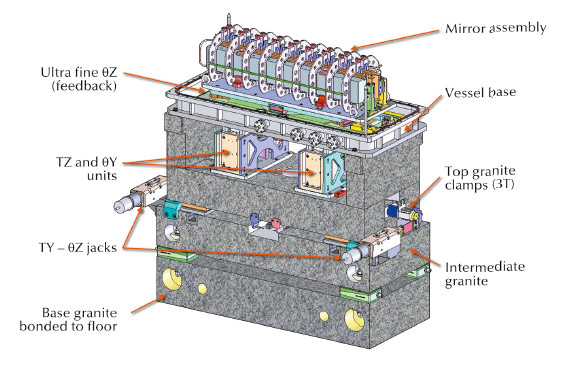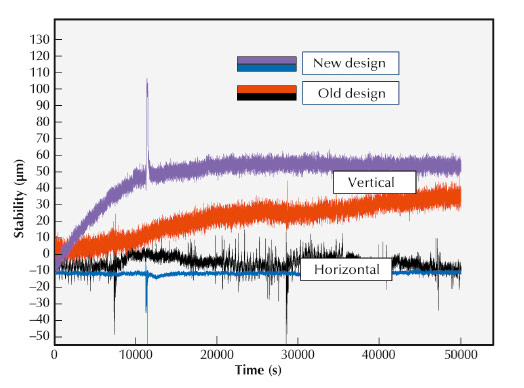- Home
- Users & Science
- Scientific Documentation
- ESRF Highlights
- ESRF Highlights 2013
- Enabling technologies
- New generation mirror systems for ESRF Upgrade beamlines
New generation mirror systems for ESRF Upgrade beamlines
Many new or refurbished beamlines constructed during the ESRF Upgrade Programme (2009 – 2015) will be equipped with white beam mirror systems. The performance objectives of these new beamlines are extremely challenging in terms of beam stability and focal spot size, leading to equally challenging specifications on opto mechanical beam delivery systems, not least the first or “white beam” mirror assembly.
High heatloads of several hundred watts coupled with extremely tight tolerances on mechanical stability and positioning mean that particularly stable supports and ultra high-precision positioning systems are mandatory to guarantee optimal performance. As white beam mirrors are the first reflective element on the beamline, any form of instability or alignment error on the mirror can be vastly magnified at the sample position, often situated more than 100 metres further downstream.
A working group was created in 2009 to address the above issues, to develop an entirely new mirror support system and to streamline design by defining generic solutions wherever possible.
At each stage, from the EXPH floor to the X ray beam axis, we have attempted to solve the conflicting engineering problem of ensuring optimal thermal and mechanical stability whilst maintaining the highest possible accuracy and sensitivity of the various positioning elements.
From the ground up, this has lead to the development of novel granite-based supports integrating motorised “air side” alignment stages in a parallel configuration (as opposed to more classical series arrangement) ensuring superior compactness and rigidity. These are grouted directly to the EXPH floor to guarantee the stiffest possible mirror support and zero vibration amplification (Figure 149).
 |
|
Fig. 149: Generic white beam mirror assembly showing high stiffness multi axis support, precision elevators. UHV fine tune mechanics and cooled optics. |
Specific ex – vacuum mirror elevators have been developed to ensure precise vertical positioning. The stiffest commercially available linear bearing stages - purchased and modified to meet our stringent requirements - are integrated into ESRF-designed “over constrained” mechanics. They show an excellent compromise between travel range, load capacity, precision, resolution and rigidity, and are now a generic subassembly manufactured and assembled in batches of 5 to 10 units.
Special attention has been paid to the management of instability caused by thermal load. Difficulties in this domain are twofold:
Firstly, protection of the mirror block from overheating and thermally induced deformation, caused by the power density of the incoming white beam. Although this problem has been largely addressed in the past and has lead to the so called “smart cut profile” optimisation of the mirror itself, additional improvements have been made to the cooling system. Careful dimensioning and pipe routing prevent vibrations from the cooling circuit reaching the mirror, while calibrated clamps ensure uniform pressure and therefore improved thermal contact between the side cooling blocks and the optics.
Secondly, thermal drift of surrounding mechanics and adjustment mechanisms due to Compton scattering. This can represent up to 20% of the total incoming beam power and, due to its diffuse nature, is extremely difficult to predict. Our proposed solutions are to carefully choose and match materials according to their coefficient of thermal expansion, to control the temperature of critical mechanical parts (independent water cooling circuits) and to implement cooled copper shielding as close as possible to the optical face.
For ultra-fine UHV beam incidence tuning and thermal expansion compensation during bakeout, high stiffness subsystems based on piezo- driven flexural elements combined with closed loop position feedback ensured by capacitive sensors have also been developed. Extensive finite element analysis, prototyping and evaluation testing were required, but angular positioning with a resolution down to 50 nanoradians is now possible.
To date, 10 generic mirror systems have been or are being installed. Results obtained from first tests are encouraging: beam quality and stability when compared to existing systems have been significantly improved, thermal drift has been controlled and, perhaps more importantly, thermal stabilisation time (time required to reach thermal equilibrium following exposure to the white beam) has been considerably reduced (Figure 150). Manufacture is often performed in batches and the assembly and installation procedures have been standardised as much as possible.
 |
|
Fig. 150: Horizontal and vertical beam position evolution following exposure to the white beam (thermal stabilisation time) - comparison between old and new designs. |
Finally, in cases where more than 4 precise motorised degrees of freedom are required to position optics (e.g. for toroidal mirrors), hexapods become an interesting option. Collaboration between the ESRF and a hexapod manufacturer (Symetrie, France) has lead to the development of a new hexapod with improved stiffness and resolution. It may be used in association with generic flexure-based “in vacuum” angular positioning units when extremely high-resolution adjustment of beam incidence or rapid angular correction are required. Such a hexapod has been installed and tested on ID20. First results are impressive: linear and angular resolution, stiffness and long term thermal stability have all been vastly improved over existing hexapods.
Authors
R. Baker (a), R. Barrett (a), C. Clavel (a), Y. Dabin (a), L. Eybert (a), T. Mairs (a), M. Mattenet (a) and J. Guillemin (b).
(a) ESRF
(b) SPRETEC, Seyssins (France)



